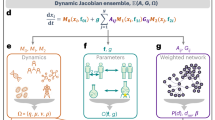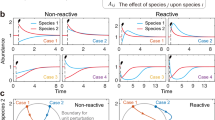Abstract
It is still not well understood how large complex systems (such as ecosystems) come into being or how they persist over long periods of time, although recent studies1–5 have clarified certain aspects of the associated stability problems. The occurrence of such systems presents no problem if a ideological assumption is valid—that is, if the variables may be presumed (or compelled) to adjust their mutual interactions in advance, to achieve the desired persistence. But when no such ‘foresight’ is credible, a real problem emerges; how a given variable can interact will generally be constrained by factors internal to it, independent of the ‘needs’ of other variables or of system stability. This consideration has prompted studies of ‘randomly-interacting’ system models, and interesting results have emerged1–4 concerning the stability of such models—that is, their capacity to return to equilibrium after a fluctuation. However, the question remains: how did such a collection of randomly-interacting entities arrive at an equilibrium in the first place? We present here results from a simple model using mutually interacting variables. We show how, even on assumptions which make large complex and persistent systems highly improbable initially, they can nevertheless be expected to arise in profusion in the normal course of time development.
This is a preview of subscription content, access via your institution
Access options
Subscribe to this journal
Receive 51 print issues and online access
$199.00 per year
only $3.90 per issue
Buy this article
- Purchase on Springer Link
- Instant access to full article PDF
Prices may be subject to local taxes which are calculated during checkout
Similar content being viewed by others
References
Gardner, M. R. & Ashby, W. R. Nature 228, 784 (1970).
May, R. M. Nature 238, 413–414 (1972).
Roberts, A. Nature 251, 607 (1974).
Gilpin, M. E. Nature 254, 173 (1975).
Tregonning, K. & Roberts, A. Bull. Math. Biol. 40, 513–524 (1978).
Wilson, E. O. in Diversity and Stability in Ecological Systems Symposium, (Brookhaven National Laboratory, 1969).
Author information
Authors and Affiliations
Rights and permissions
About this article
Cite this article
Tregonning, K., Roberts, A. Complex systems which evolve towards homeostasis. Nature 281, 563–564 (1979). https://doi.org/10.1038/281563a0
Received:
Accepted:
Published:
Issue Date:
DOI: https://doi.org/10.1038/281563a0
This article is cited by
-
Process-based forward numerical ecological modeling for carbonate sedimentary basins
Computational Geosciences (2017)
-
Multi‐faceted approaches toward unravelling complex ecological networks
Population Ecology (2015)
-
A universal transition in the robustness of evolving open systems
Scientific Reports (2014)
-
Self-organization in an ecosystem
Artificial Life and Robotics (2002)
-
The complexity and stability of ecosystems
Nature (1984)
Comments
By submitting a comment you agree to abide by our Terms and Community Guidelines. If you find something abusive or that does not comply with our terms or guidelines please flag it as inappropriate.



